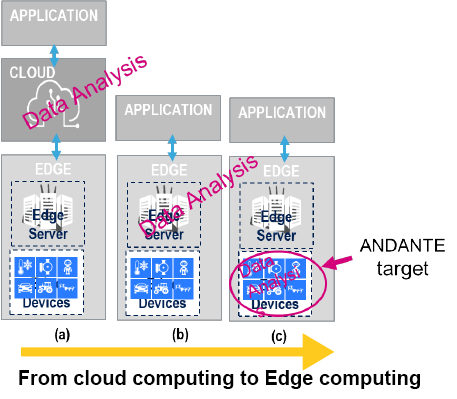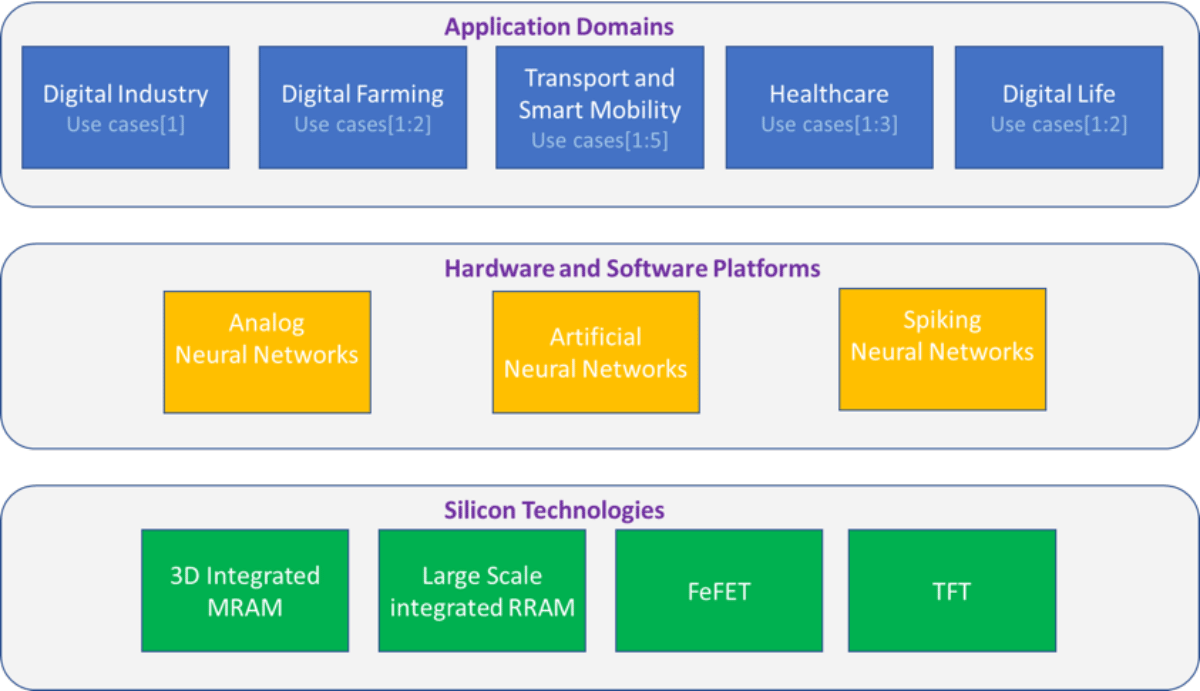ANDANTE in context
The advent of technologies such as Artificial Intelligence (AI) and the Internet of Things (IoT), and their use in a multitude of applications in the Cloud has led to identify that the processing / data analysis of raw data does not need to reside in the cloud. The data analytics can well be done, for manty applications, in the periphery of the network (“Edge”). This has led to focusing on so-called “Edge computing” solutions, compared to “Cloud computing”. See next Figure.

Date Analysis migration from Cloud to Edge domain Edge computing-based solutions are implemented close to the data source, which gives them the following advantages:
- Reduce latency and thus allow applications to be carried out in real time.
- Reduce energy consumption because the data analysis is performed locally without the need to transmit all the raw data gathered but only insight data when needed.
- Reduce data memory storage because in many applications data processing will be done online avoiding its copy and storage.
- Ensure greater data security because the attack surface is smaller, less exposure to data transmission.
- Easily guarantee the protection of personal data (“Privacy”) because data access will be much more restricted and better controlled, eventually randomized or coded.
Main Challenges
- To develop of ultra-low power technologies implementing a significant among of embedded memory (10 to 100 Mbytes).
- To design innovative AI processors (Artificial and Spiking neural networks with very with high processing performance at ultra-low power ( >>1 TOPS/W)
ANDANTE’s Approach as a way to address such challenges
Figure below illustrates the ANDANTE’s approach.
- The development of different types of embedded Non-Volatile Memories: 3D integrated MRAM, Large scale integrated RRAM and FeFET.
- Design Different Neuromorphic accelerators based on different architectures of neural networks Artificial, Spiking .and Analog.
- Create a module HW and SW dedicated to one or two Neuromorphic processors and use them as accelerators to a host (MCU/MPU) to have an AI processing unit.
- Use these modules in 5 different domains for 13 use cases.

ANDANTE’s expectations
Neuromorphic solutions will be the workhorse in many application areas, whether it will be human machine interaction, autonomous robotic navigation, smart mobility, digital farming or environmental protection. All those applications will have major societal impacts and must be dealt with at the European level, for many well-understood reasons: strategic independence, economic fallout, a more ethics-based approach, … and not the least sustainability in many areas of our daily life.
The ambition of the ANDANTE project is very clear in that respect: it is to implement competitive embedded non-volatile memory technologies (28 nm and beyond) to design artificial neural networks and neuromorphic circuits to support complex algorithms for “intelligent” and innovative applications, upon which a neuromorphic roadmap can be built and sustained in the long run to preserve the leadership and technology independency of the European industry in general.
Ambition at the technology level
The development of several memory technologies namely MRAM, RRAM and FeRAM is consolidated. The reasons to follow this approach are twofold: first, those memory technologies have their own advantages and drawbacks, exhibiting different trade-offs in cyclability, retention time, memory window, access energy …. Each technology type might be beneficial for given classes of applications, implementation strategies or information coding types. Secondly, this reduces the probability of occurrence of a blind spot, with the project partners missing the next “big thing” in memory technology. The ANDANTE project will push those memory technologies to the next level of integration complexity, targeting unprecedented eNVM memory densities, up to 100MB on chip.
Ambition at the circuit level
The AI processors designs, initially restricted to Deep learning application running in the Cloud, are evolving to cover a wide range of applications implementations in the Edge:
- Edge AI applications: autonomous car, surveillance cameras, USB sticks
- Embedded AI applications: smartphones, drones
- AIoT: wearables, IoT sensors
The power envelop ranges of those different applications go from less than 1 mW to several dozens of Watts, i.e. 5 to 6 orders of magnitude. One ambition of ANDANTE project is to cover a large range of applications at the EDGE, with energy efficiencies improved, at application level, by at least 5X. One of the keys to strongly reduce the power dissipation is to process data locally, i.e. avoiding external memory speed accesses and bottlenecks. This is what all current inference accelerators such as nVidia Jetson and Google Edge TPU are lacking. All of them rely on huge external DRAM memory banks with their related performance penalties for instance in power consumption and latency. Data locality puts a strong emphasis on having the densest on-chip memory possible. Another key aspect is to develop an architecture which efficiently handles sparsity of input data and/or weights. All these mentioned aspects, that ANDANTE will address, will have a strong positive impact in the final circuit performances: higher computing capabilities, low power consumption and low latency compared to the existing designs.
At the circuit implementation level, several trends co-exist, for instance analog vs digital implementation, or spiking vs classical coding. Depending on the targeted sensor or application, one solution may prevail. Several approaches may even co-exist. For instance, one can envision an asymmetric system, with an ultra-low-power, event-based sub-system, and a compute-intensive, on-demand subsystem. Wake-up event will typically be generated with spike-based neural network and event-based sensor. Compute-intensive processing will handle vision sensors and extract high-level information. The combination of these two circuit types will be investigated in ANDANTE to obtain more intelligent and performant applications.
The targeted AI circuits processing power as function for the application ranges from less than 0.5 TMAC (or TOPs) to several dozens. Obviously, the less energy is dissipated, the better. Even a self-driving car will have stringent requirements, especially if it is an all-electric vehicle: the total power dissipation must be below 10W.
By combining architectural innovations, large embedded memories and circuit innovations, the ambition is to reach energy efficiencies of at least 10 TOPS/W for classical coding accelerators. For spike coding accelerators, the ambition is to perform real-time bio-signal processing at around 100µW of continuous power consumption, and real-time vision analysis for presence detection at around 1mW of continuous power consumption.
Ambition at the tools level
One of the challenges of this project, apart from developing technology and designing circuits, is to develop the necessary set of tools for enabling algorithms and architecture exploration and the correspond trade-offs, and neural network mapping.
Architecture/algorithms exploration end results will have a tremendous impact on final application performances. The ambition is thus to have tools that (1) enable architecture exploration, (algorithms validation) and (2) consider memory technology parameters, to fulfill application requirements.
Once the architecture is set, the API (Application Programming Interfaces) must be properly defined for successfully mapping applications onto hardware accelerators. Software Design Kits will be developed for the corresponding hardware accelerators. The ambition is to have efficient mapping tools: those tools will do weight quantization and compression, neural net pruning, sparsity management and hardware resource allocation.
Ambition is clearly to have professional-grade tools. This will be assessed using the System Usability Scale (SUS) Score: a grade of at least B is targeted.
Ambition at the application level
Foreseen applications are in the fields of Digital Industry, Digital Farming, Transport and Smart Mobility, Healthcare and Digital Life. Several uses cases in these domains are the following:
In the Digital Farming domain, ambition is first to enable precision weeding of intra row crops. Another ambition is also to increase the environmental sustainability and the crop yield. This will be applied within the project to tomato production.
In the Transport and Smart Mobility domain, the first ambition is to address automated driving that is a rapidly progressing area of automobile engineering aiming to decrease accidents while reducing gradually human interaction in automobile driving. The ambition is to boost the performance of object detection and classification beyond the state of the art by fusing LiDAR and camera processing on embedded neuromorphic hardware. In the field of aerial transportation (both for goods logistics and people), robust autonomous landing is one of the critical processes that needs to be successfully addressed for unleashing the day-to-day use of UAV (Unmanned Aerial Vehicles). In this framework, the communication between the UAV and a ground control station (or the autonomous traffic control station) is critical to guarantee safety and security of operations, especially during autonomous landing. Finally, underwater sound detection by underwater drones is also considered in ANDANTE.
In the Healthcare domain, ambition is to perform clinical object detection and image segmentation using DL technology. State-of-the-art computer vision algorithms perform compute intensive image analysis on a frame-by-frame basis and as such do not consider the temporal aspects of X-ray video sequences. The inherent capability of SNNs to capture and process temporal aspects in X-ray video sequences will lead to better performing SW applications for medical image analysis.
Ambition: Outcomes
The outcomes of ANDANTE will be in several areas:
- Memory technologies
- AI processing ASICs for edge computing applications
- Hardware and Software Platforms
- Use cases in different application domains.
ANDANTE’s unique value proposition
- Unique hardware and software platforms to develop efficient Artificial and Spinking Neural Networks Edge solution.
- Advanced and ultra-low power silicon technologies based in-memory computing architectures.
- Confirm the applicability of the developed technologies un several applications domains.
